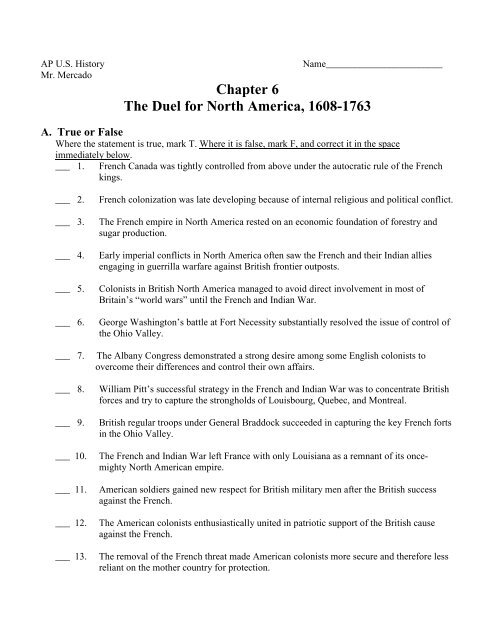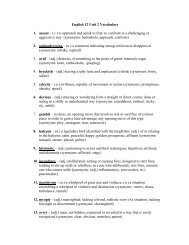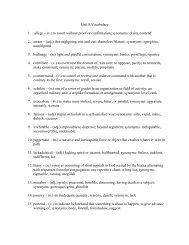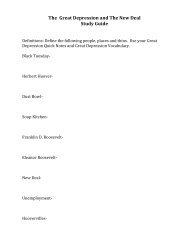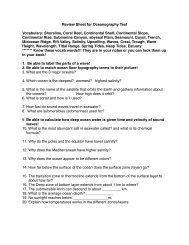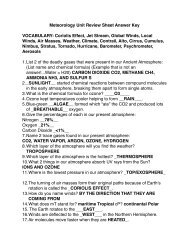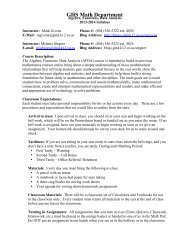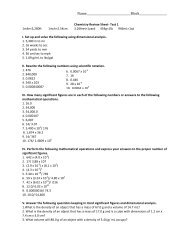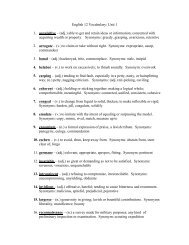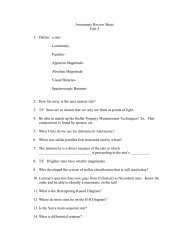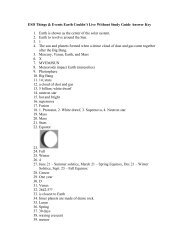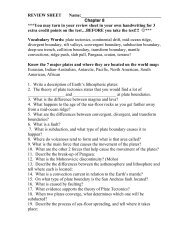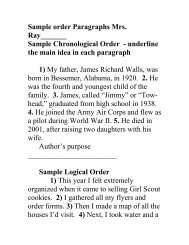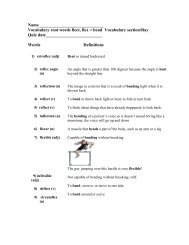Ch. 6 Homework Questions
Ch. 6 Homework Questions
Ch. 6 Homework Questions
You also want an ePaper? Increase the reach of your titles
YUMPU automatically turns print PDFs into web optimized ePapers that Google loves.
AP U.S. History<br />
Mr. Mercado<br />
Name________________________<br />
<strong>Ch</strong>apter 6<br />
The Duel for North America, 1608-1763<br />
A. True or False<br />
Where the statement is true, mark T. Where it is false, mark F, and correct it in the space<br />
immediately below.<br />
___ 1.<br />
French Canada was tightly controlled from above under the autocratic rule of the French<br />
kings.<br />
___ 2.<br />
___ 3.<br />
___ 4.<br />
___ 5.<br />
___ 6.<br />
___ 7.<br />
___ 8.<br />
___ 9.<br />
___ 10.<br />
___ 11.<br />
___ 12.<br />
___ 13.<br />
French colonization was late developing because of internal religious and political conflict.<br />
The French empire in North America rested on an economic foundation of forestry and<br />
sugar production.<br />
Early imperial conflicts in North America often saw the French and their Indian allies<br />
engaging in guerrilla warfare against British frontier outposts.<br />
Colonists in British North America managed to avoid direct involvement in most of<br />
Britain’s “world wars” until the French and Indian War.<br />
George Washington’s battle at Fort Necessity substantially resolved the issue of control of<br />
the Ohio Valley.<br />
The Albany Congress demonstrated a strong desire among some English colonists to<br />
overcome their differences and control their own affairs.<br />
William Pitt’s successful strategy in the French and Indian War was to concentrate British<br />
forces and try to capture the strongholds of Louisbourg, Quebec, and Montreal.<br />
British regular troops under General Braddock succeeded in capturing the key French forts<br />
in the Ohio Valley.<br />
The French and Indian War left France with only Louisiana as a remnant of its oncemighty<br />
North American empire.<br />
American soldiers gained new respect for British military men after the British success<br />
against the French.<br />
The American colonists enthusiastically united in patriotic support of the British cause<br />
against the French.<br />
The removal of the French threat made American colonists more secure and therefore less<br />
reliant on the mother country for protection.
Kennedy <strong>Ch</strong>. 6 <strong>Homework</strong> Packet Page 2<br />
___ 14.<br />
___ 15.<br />
A British commander used the harsh tactics of distributing blankets inflected with<br />
smallpox to suppress Pontiac’s Indian uprising.<br />
The British government’s attempt to prohibit colonial expansion across the Appalachian<br />
Mountains aroused colonial anger and defiance of the law.<br />
B. Multiple <strong>Ch</strong>oice<br />
Select the best answer and write the proper letter in the space provided.<br />
___<br />
___<br />
1. Compared with the English colonies, New France was<br />
a. more wealthy and successful.<br />
b. better able to maintain consistently friendly relations with the Indians.<br />
c. more heavily populated.<br />
d. more autocratically governed<br />
2. The expansion of New France occurred especially<br />
a. in the interior mountain areas.<br />
b. along the paths of lakes and rivers.<br />
c. in areas already occupied by English settlers.<br />
d. to the north of the original St. Lawrence River settlement.<br />
___ 3. Colonial Americans were unhappy after the peace treaty following the “War of Jenkin’s Ear”<br />
because<br />
a. it failed to settle the issue that had caused the war.<br />
b. it gave the Louisbourg fortress they had captured back to France.<br />
c. it created further conflicts with Spain.<br />
d. it failed to deal with the issue of Indian attacks on the frontier.<br />
___<br />
___<br />
4. The original cause of the French and Indian War was<br />
a. conflict in Europe between Britain and France.<br />
b. British removal of the “Acadian” French settlers from Nova Scotia.<br />
c. competition between French and English colonials for land in the Ohio River valley.<br />
d. the French attack on George Washington’s Virginia headquarters.<br />
5. The French and Indian War eventually became part of the larger world conflict known as<br />
a. the Seven Years’ War.<br />
b. the War of Jenkins’s Ear.<br />
c. the War of the Austrian Succession.<br />
d. King George’s War.<br />
___ 6. Benjamin Franklin’s attempt to create intercolonial unity at the Albany Congress resulted in<br />
a. a permanent cooperative organization of the colonies.<br />
b. rejection of the congress’s proposal for colonial home rule by London and by the<br />
individual colonies.<br />
c. a sharp increase in Indian attacks on colonial settlements.<br />
d. a growing colonial sympathy with France in the war against Britain.
Kennedy <strong>Ch</strong>. 6 <strong>Homework</strong> Packet Page 3<br />
___ 7. The British forces suffered early defeats in the French and Indian War under the overall<br />
command of<br />
a. General Braddock.<br />
b. General Washington.<br />
c. General Wolfe.<br />
d. General Montcalm.<br />
___ 8. William Pitt’s strategy in the assault on New France finally succeeded because<br />
a. he was able to arouse more support for the war effort from the colonists.<br />
b. he gave full support to General Braddock as commander of the British forces.<br />
c. he concentrated British forces on attacking the vital strong points of Quebec and<br />
Montreal.<br />
d. he was able to gain the support of the British aristocracy for the war effort.<br />
___ 9. The decisive event in the French-British contest for North America was<br />
a. the British capture of Fort Duquesne.<br />
b. the British victory in the Battle of Quebec.<br />
c. the British capture of the Louisbourg fortress.<br />
d. the British attack on the West Indies.<br />
___<br />
___<br />
___<br />
10. Among the factors that tended to promote intercolonial unity during the French and Indian<br />
War was<br />
a. religious unity.<br />
b. common language and wartime experience.<br />
c. ethnic and social harmony.<br />
d. improved transportation and settlement of boundary disputes.<br />
11. The French and Indian War weakened interior peoples like the Iroquois and Creeks by<br />
a. establishing new American settlements on their territory.<br />
b. eliminating their most effective leaders.<br />
c. ending their hopes for diplomatic recognition in Europe.<br />
d. removing their French and Spanish allies from Canada and Florida.<br />
12. Pontiac’s fierce attack on frontier outposts in 1763 had the effect of<br />
a. ending good American-Indian relations on the frontier.<br />
b. reviving French hopes for a new war.<br />
c. convincing the British to keep troops stationed in the colonies.<br />
d. stopping the flow of westward settlement.<br />
___ 13. The British Proclamation of 1763<br />
a. was welcomed by most American colonists.<br />
b. angered colonists who thought that it deprived them of the fruits of victory.<br />
c. was aimed at further suppressing the French population of Canada.<br />
d. halted American westward settlement for several years.
Kennedy <strong>Ch</strong>. 6 <strong>Homework</strong> Packet Page 4<br />
___<br />
14. The French and Indian War created conflict between the British and the American<br />
military because<br />
a. the American soldiers had failed to support the British military effort.<br />
b. the British regulars had carried the brunt of the fighting.<br />
c. British officers treated the American colonial militia with contempt.<br />
d. American soldiers refused to accept orders from British officers.<br />
___ 15. The effect on the colonists of the French removal from North America was<br />
a. to increase their gratitude to Britain for defending them in the war.<br />
b. to create new threats to colonial expansion from Spain and the Indians.<br />
c. to reduce the colonies’ reliance on Britain and increase their sense of independence.<br />
d. to focus colonial energies on trade.<br />
C. Identification<br />
Supply the correct identification for each numbered description.<br />
___________ 1. French Protestants who were granted toleration by the Edict of Nantes in 1598<br />
but not permitted to settle in New France<br />
___________ 2. Absolute French monarch who reigned for seventy-two years<br />
__________ 3. Animal whose skin provided great profits for the French empire and enhanced<br />
European fashion at enormous ecological cost<br />
__________ 4. French Catholic missionary order that explored the North American interior<br />
and sought to protect and convert the Indians<br />
_________ 5. Far-running, high-living French fur trappers<br />
_________ 6. Strategic French fortress conquered by New England settlers, handed back to<br />
the French, and finally conquered again by the British in 1759<br />
__________ 7. Inland river territory, scene of fierce competition between the French and landspeculating<br />
English colonists<br />
__________ 8. Bloodiest European theater of the Seven Years’ War, where Frederick the<br />
Great’s troops drained French strength away from North America<br />
__________ 9. Unification effort that Benjamin Franklin nearly led to success by eloquent<br />
leadership and cartoon artistry<br />
_________ 10. Military aid of British General Braddock and defender of the frontier after<br />
Braddock’s defeat<br />
_________ 11. Fortress boldly assaulted by General Wolfe, spelling doom for New France
Kennedy <strong>Ch</strong>. 6 <strong>Homework</strong> Packet Page 5<br />
__________ 12. The “buckskin” colonial soldiers whose military success did nothing to alter<br />
British officers’ contempt<br />
__________ 13. Allies of the French against the British, who continued to fight under Pontiac<br />
even after the peace settlement in 1763<br />
__________<br />
14. Name for larger European struggle of which the French and Indian war was part<br />
D. Matching People, Places, and Events<br />
Match the person, place, or event in the left column with the proper description in the right column by<br />
inserting the correct letter on the blank line.<br />
___ 1. Samuel de <strong>Ch</strong>amplain<br />
___ 2. Robert de la Salle<br />
___ 3. Albany<br />
___ 4. War of Austrian<br />
Succession<br />
___ 5. Fort Duquesne<br />
___ 6. George Washington<br />
___ 7. Benjamin Franklin<br />
___ 8. General Braddock<br />
___ 9. William Pitt<br />
___ 10. Plains of Abraham<br />
___ 11. Seven Years’ War<br />
___ 12. Pontiac<br />
___ 13. Proclamation of 1763<br />
___ 14. New Orleans<br />
___ 15. Acadians (Cajuns)<br />
A. Advocate of colonial unity at the unsuccessful Albany Congress<br />
B. Document that aroused colonial anger but failed to stop<br />
frontier expansion<br />
C. One-time French territory, renamed Nova Scotia, whose<br />
citizens were removed to Louisiana by the British in 1755<br />
D. Conflict that started with War of Jenkin’s Ear (called King<br />
George’s War in North America) and ended with return to<br />
Louisbourg to France<br />
E. Strategic French outpost at the mouth of the Mississippi,<br />
handed over to Spain in the peace treaty of 1763<br />
F. Leader whose frontier uprising, crushed by harsh British tactics,<br />
caused British to attempt to limit colonial frontier expansion<br />
G. Blundering British officer whose defeat gave the advantage to<br />
the French and Indians in the early phase of the war<br />
H. The Father of New France, who established a fateful<br />
alliance with the Huron Indians<br />
I. Site of the death of Generals Wolfe and Montcalm, where<br />
France’s New World empire also perished<br />
J. Strategic French stronghold, later renamed after a great<br />
British statesman<br />
K. Militia commander whose frontier skirmish touched off a<br />
world war<br />
L. Site of a meeting that proposed greater unity and home rule<br />
among Britain’s North American colonies<br />
M. Conflict that, in Europe, pitted France against Britain’s<br />
ally, Frederick the Great of Prussia<br />
N. French empire builder who explored the Mississippi basin<br />
and named it after his monarch<br />
O. Splendid political orator and organizer of a winning<br />
strategy against the French in North America
Kennedy <strong>Ch</strong>. 6 <strong>Homework</strong> Packet Page 6<br />
E. Matching Cause and Effect<br />
Match the historical cause in the left column with the proper effect in the right column by writing the<br />
correct letter on the blank line.<br />
Cause<br />
Effect<br />
___ 1. French fur trade A. Resulted in decisive French defeat and British<br />
domination of North America<br />
___ 2. Four “world wars” between 1688 and<br />
1763<br />
B. Prompted widespread Indian assaults on the<br />
weakly defended colonial frontier.<br />
___ 3. Competition for land and furs in the Ohio<br />
Valley<br />
C. Led to Washington’s expedition and battle with<br />
the French at Fort Necessity.<br />
___ 4. Summoning of Albany Congress by<br />
British<br />
D. Heightened colonial anger and renewed<br />
westward expansion.<br />
___ 5. William Pitt’s assumption of control of<br />
British government and strategy<br />
E. Increased colonial military confidence and<br />
resentment of British redcoats.<br />
___ 6. Wolfe’s victory over Montcalm at Quebec F. Decimated beaver populations while<br />
spreading French empire.<br />
___ 7. Colonial militia’s military success in<br />
French and Indian War<br />
G. Were echoed by four small wars between<br />
French and British subjects in North America<br />
___ 8. Colonial American smuggling and trading<br />
with French enemy<br />
H. Represented the first major attempt at<br />
intercolonial unity<br />
___ 9. British issuance of Proclamation of 1763 I. Increased British government’s disdain for<br />
colonial Americans and distrust of their loyalty<br />
to the empire<br />
___ 10. Braddock’s defeat at Fort Duquesne J. Ended a string of defeats and turned French and<br />
Indian War in Britain’s favor<br />
F. Map Discrimination<br />
Using the maps and charts in <strong>Ch</strong>apter 6, answer the following questions.<br />
1. Around which great river valley was New France first colonized? _________________<br />
2. Which French colonial settlement on the Great Lakes linked the St. Lawrence and Mississippi<br />
River basins? _________________________<br />
3. Along which river, besides the Mississippi, was the greatest number of French fur-trading posts<br />
located? __________________<br />
4. In the peace treaty of 1763, which nation besides Britain acquired North American territory from<br />
France? __________________<br />
5. Which North American territory owned by Spain before 1754 was acquired by Britain in the peace<br />
of 1763? _________________


